Why Does the Oldest Chinese Buddha Figure Slump?
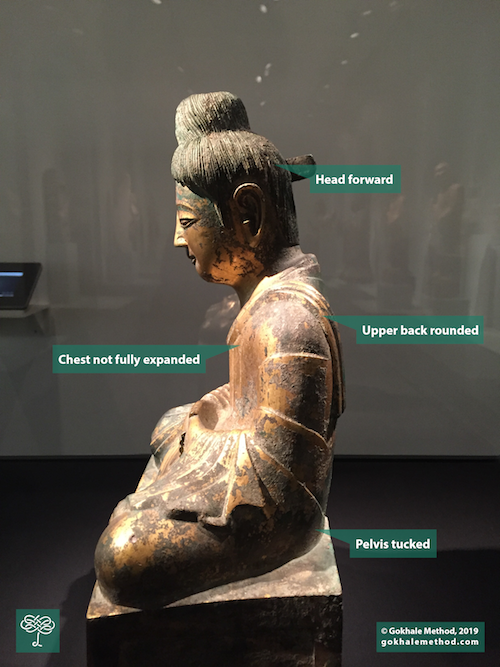
The oldest surviving dated Chinese Buddha figure shows surprisingly slumped posture. Note the forward head, absence of a stacked spine, and tucked pelvis. He would not look out of place with a smartphone in his hand!
This surprisingly hunched Chinese Buddha figure is the oldest dated Chinese Buddha figure that has survived into modern times. The inscription on its base dates it to 338 AD, 500 years after Buddhism came to China from India. Compare the Chinese Buddha figure with this Indian Buddha figure from roughly 800-1000 AD…
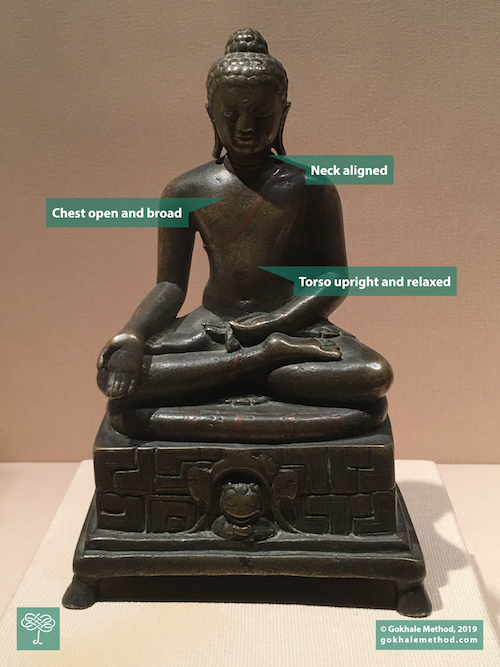
This North Indian Buddha figure from the post-Gupta period (7th - 8th century AD) shows excellent form. He has a well-stacked spine, open shoulders, and an elongated neck.
There is a dramatic difference in posture. The Chinese figure looks like a lot of modern folk, whereas the Indian one looks upright and relaxed. Why the difference?
Since the models these figures were based on, and everything and everyone contemporaneous to them are long dead, the best we can do is to make educated guesses about these characters.
India, compared to China, is a warm country. Much of the Indian population sits on the floor cross-legged to gather, eat, play, socialize, and more. To this day, the default praying position is cross-legged without props.

Devotees attending a puja in a temple in Bhubansewar, Orissa.
China, by contrast, is generally a cold country, being further north. It is not comfortable to sit cross-legged on the floor in a cold country, and accordingly, it is common for Han Chinese people to use furniture. In fact, China has many famous styles of furniture, like Ming and Qing Dynasty furniture, and the oldest sitting implements date to earlier than 1000 BC.
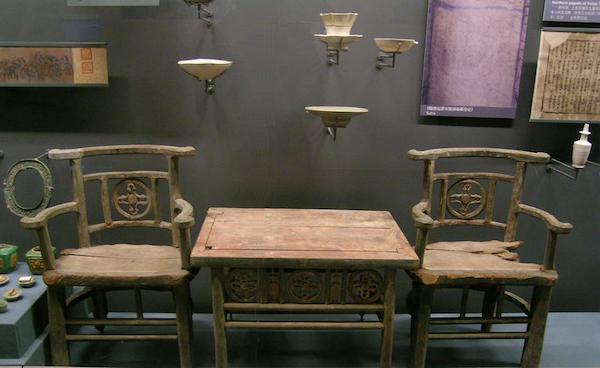
This historical northern Chinese furniture dates back to the Liao Dynasty (907-1125 AD). Though they are weathered, the chairs’ armrests, backrests, and seat shape give clues about posture in this period. Original image is licensed by Wikimedia Commons user smartneddy under CC BY-SA 2.5.
As is true in our culture, when people sit on chairs, stools, and benches, the hip socket (acetabulum) is not subject to the same forces as in a person who sits cross-legged on the floor habitually. In my blog post about cross-legged sitting, I use a common-sense argument about why the shape of the hip sockets of someone who grew up sitting on the floor are different from those of someone who grew up sitting on chairs. By the time we are 16 years old, the hip socket is entirely ossified and not amenable to significant shaping or “editing”. For this reason, most modern people from colder climates cannot sit comfortably on the floor for long periods without props. This is also why, I conjecture, this oldest Chinese Buddha figure shows an awkward and uncomfortable posture as he sits cross-legged without props.
I imagine the model for the Chinese Buddha statue to have been a dedicated seeker, eager to embody every aspect of his chosen spiritual tradition. Some of these borrowed aspects would have worked well, probably bestowing on him benefits in his chosen path and practice. The borrowed posture, however, does not help him. He would do better with a prop. If he used a prop to elevate his ischial tuberosities (sitz bones) and let his pelvis tip forward, he would all of a sudden discover that he could be upright without any tension or effort. His back could rise and fall with his inhalations and exhalations. And he would be spared much degeneration and discomfort. My guess is that he had the skills to work with much of his pain, but maybe not all of it, maybe not all the time, and maybe not into his old age. The mind has amazing capabilities to override pain signals, but when those pain signals can be quite addressed at their root with simple mechanical solutions, this is worth learning how to do. The mind can then be used to try to address more unavoidable pain, both physical and emotional.
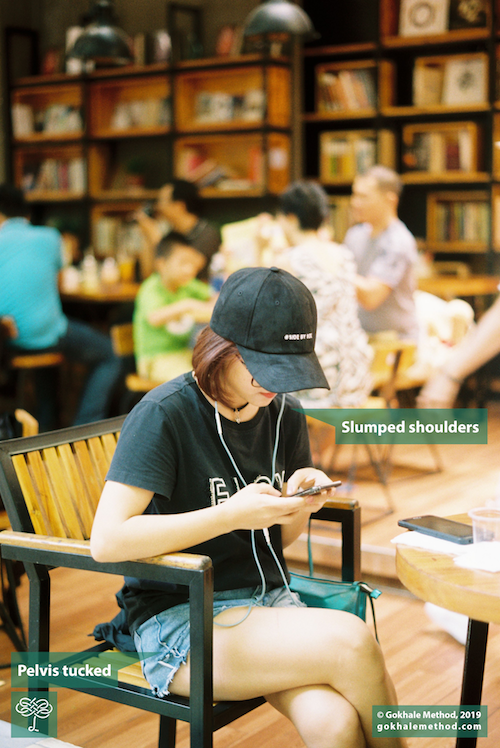
This young woman’s posture, with her protruding head, slumped shoulders, and tucked pelvis, shares many similarities with that of the ancient Chinese Buddha figure. Original image courtesy Andrew Le on Unsplash.
With such slumped posture, my experience indicates that the model’s chest and back would be encumbered by the cantilevered weight of the upper body, and not available for easy expansion. Only the belly is readily available for expansion. The person would learn to soften the belly to allow for easier expansion with the breath. In my imaginings, the belly breathing pattern that started out as a hack could easily get mistaken for a desirable practice to emulate. And this misperception continues into modern times.
If there is any truth to this storyline, the posture demonstrated by the oldest Chinese Buddha figure serves as a cautionary tale. It reminds us that practices develop and thrive in a culturally-specific context. When we import a practice from a different context, it behooves us to consider which portions of the practice can be imported whole, which need modification for local conditions and use, and which need to be edited out of our local version of the practice.
Centuries later, in Japan, Buddhist practitioners invented the zafu, the perfect prop for hip sockets of the kind found in cold countries. A zafu enables a modern meditator to be upright and relaxed, just like the Buddha!
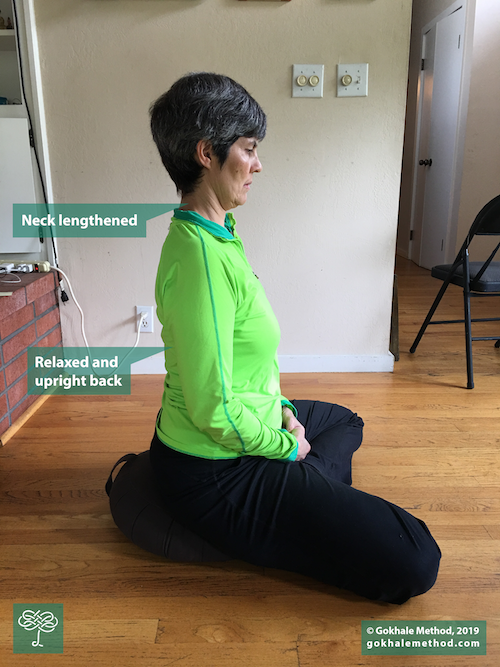
Elevating the seat can make a big difference in meditation posture.
Do you engage in practices you find challenging that are easy in the country of their origin? How have you modified an “imported” cultural practice?

Comments
Thoughtful perspective, thank
Thoughtful perspective, thank you Esther.
A belly-breathing comment - it's really interesting to consider that it was a hack. As a possible hack, it led to some very useful results in terms of alterations of consciousness, which was probably their main focus. Drawing the energy of the breath down into the belly, which if the extant texts are correct, was what peoples of that time considered the center of their being, pretty much the way we consider our heads/brains today, helped calm the mind in a way that other breathing patterns do not - 'Ocean-breath' the feeling of being in the deep unperturbed by any storms on the surface. Chest-based breathing is excellent for everyday consciousness and clear awareness. Belly-based breathing is not good for this, a lesson I learned from you.
I also wonder if people of that time share something that I find common in spiritually-oriented people of our time - the body as a vehicle to achieve enlightenment, not as an active 'partner' in the process; in quotes only because contemporary language makes it difficult not to get dualistic. "Feeling" the picture of the first Buddha, it looks like he's leaving his body behind. In the second picture, the Buddha looks fully embodied.
Thank you for your wisdom and
Thank you for your wisdom and experience! Your musings on belly breathing are intriguing. Also on asymmetry in the partnership between the body and spirit in enlightenment.
To clarify my position: There's no question that belly breathing has a useful and important place among many possible breathing mechanisms. You are describing one such use. Belly breathing is also very important in singing and playing wind instruments. It's just as a default that I believe it's out of place.
" It's just as a default that
" It's just as a default that I believe it's out of place. "
Yes, that was the lesson for me. It had become the default without awareness on my part.
I found this meditation bench
I found this meditation bench much more comfortable than sitting cross-legged. Note the forward slant.
Thank you for this
Thank you for this fascinating article. Your observations resonated with me.
The Buddha described the seated meditative posture that monastics should adopt as,
"And how is mindfulness of breathing developed and cultivated to be very fruitful and beneficial? It’s when a mendicant has gone to a wilderness, or to the root of a tree, or to an empty hut. They sit down cross-legged, with their body straight, and establish mindfulness right there.Just mindful, they breathe in. Mindful, they breathe out.
When breathing in heavily they know: ‘I’m breathing in heavily.’ When breathing out heavily they know: ‘I’m breathing out heavily. When breathing in lightly they know: ‘I’m breathing in lightly.’ When breathing out lightly they know: ‘I’m breathing out lightly. They practice breathing in experiencing the whole body. They practice breathing out experiencing the whole body. They practice breathing in stilling the body’s motion. They practice breathing out stilling the body’s motion."
Ajahn Sujato's translation of the Anapanasati Sutta (Discourse on Mindfulness of Breathing), Majjhima Nikaya 118 available at https://suttacentral.net/mn118/en/sujato
Note that the body needs to be straight. And the mindful awareness that needs to be cultivated is of the entire body of breath, the entire body as it breathes in and out. So the posture that facilitates this complete awareness would be the correct posture. That is not awareness of the breath in just the belly, but in the entire body, and in the process of breathing and awareness, calming the body and making it and the mind still and tranquil.
I think that these words of the Buddha can be adduced as textual evidence that the posture depicted in the Indian Buddha statue is more conducive to the relaxed awareness of the body of breath, than the posture adopted by the Chinese Buddha, which is likely to increase tension rather than induce relaxation. You explain this very clearly in your article above.
Add New Comment
Login to add commment
Login